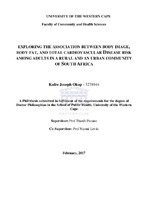| dc.contributor.advisor | Puoane, Thandi | |
| dc.contributor.advisor | Levitt, Naomi | |
| dc.contributor.author | Okop, Kufre Joseph | |
| dc.date.accessioned | 2017-10-02T10:15:23Z | |
| dc.date.available | 2017-10-02T10:15:23Z | |
| dc.date.issued | 2017 | |
| dc.identifier.uri | http://hdl.handle.net/11394/5599 | |
| dc.description | Philosophiae Doctor - PhD | en_US |
| dc.description.abstract | Background: Obesity is increasing worldwide, and cultural perception of body image is considered an important contributor to the obesity epidemic among black Africans. Aim: To explore the association between body image perceptions and perceived obesity threat, change in adiposity, and total cardiovascular disease (CVD) mortality risk. Study Design: This is a mixed-methods study embedded in the PURE longitudinal cohort study involving adults aged 35-78 years in South Africa. Data Collection/Analysis: This included analysis of baseline cross-sectional data, the conduct of a qualitative study and a cross-sectional follow-up survey. Sex-specific logistic regression models of excessive adiposity were determined. Body image perception indexes were obtained based on 'Feel- Ideal' difference (FID) and 'Feel-Actual' discordance (FAD). Bivariate analyses and analysis of variance were used to determine the relationships between body image and adiposity, annual changes in weight and adiposity. The correlations between body image indexes (FID and FAD) and total 10- year CVD risk score were determined – controlling for possible confounders. Qualitative data was managed with ATLAS-ti software and analysed thematically. Results: The prevalence of excessive body fat at baseline and at 5-year follow-up based on body fat percent were 96.0% and 79.6% for women, and 44.3% and 62.2% for men respectively. The majority of the obese (85%) and overweight (79%) participants underestimated their weight, and weight discordance status was inversely associated with the willingness to lose weight. Mean total 10-year CVD risk score was 18.7%, and 61% of men and 26% of women with body mass index (BMI) ≥ 25 kg/m2 had CVD risk scores ≥ 20%. Bivariate analyses indicated that FID and FAD were significantly associated with annual changes in weight and adiposity. FAD index had a significant but weak correlation with total CVD risk score (r = 0.13, p-value = 0.001) when adjusted for covariates. Conclusion: Body image discordance was associated with an annual change in adiposity, total 10- year CVD risk scores, and there was poor obesity risk perception, and low motivation towards weight loss among predominantly obese black adults with negative body image. Interventions to reduce obesity need to address negative body image, poor obesity risk perception, self-efficacy and motivation towards weight loss. | en_US |
| dc.description.sponsorship | National Research Foundation; Chromnic Disease Initiative for Africa (CDIA); National Institute of Health (NIH) | en_US |
| dc.language.iso | en | en_US |
| dc.publisher | University of the Western Cape | en_US |
| dc.subject | South Africa | en_US |
| dc.subject | Cardiovascular disease risk | en_US |
| dc.subject | Perception | en_US |
| dc.subject | Obesity | en_US |
| dc.subject | Body image | en_US |
| dc.title | Exploring the association between body image, body fat, and total cardiovascular disease risk among adults in a rural and an urban community of South Africa | en_US |
| dc.rights.holder | University of the Western Cape | en_US |

